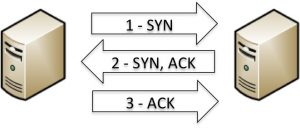TCP port scanning
Throughout this chapter, several different approaches to TCP scanning will be addressed. These techniques include stealth scanning, connect scanning, and zombie scanning. To understand how these scanning techniques work, it is important to understand how TCP connections are established and maintained. TCP is a connection-oriented protocol, and data is only transported over TCP after a connection has been established between two systems. The process associated with establishing a TCP connection is often referred to as the three-way handshake. This name alludes to the three steps involved in the connection process. The following diagram illustrates this process in graphical form:

A TCP SYN packet is sent from the device that wishes to establish a connection with a port of the device that it desires to connect with. If the service associated with the receiving port accepts the connection, it will reply to the requesting system with a TCP packet that has both the SYN and ACK...




































































